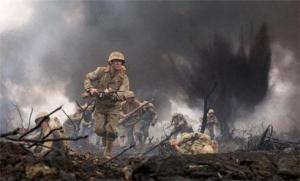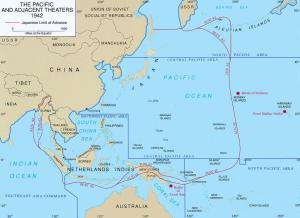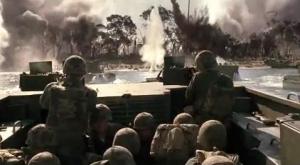The Second World War is a massive subject, so I will endeavor to stick closely to the subject of The Pacific – the land war fought by the marines in the South Pacific and on the islands surrounding Japan. This will be very difficult for me…those who have had the misfortune of experiencing one of my rants about military history no doubt know that I have a tendency to get a bit overexcited. So, please forgive me for any subsequent deviations from the main theme.
When you think about the Pacific War, you need to think about two things: naval and air power. So much of our modern view of the military application of naval and air power is the product of WWII. When we examine the late 1930s and early 1940s, we need to understand that military thinking was quite different then. For example – the destruction of two-thirds of the Russian fleet at the hands of Admiral Togo in the 1905 Battle of Tsushima convinced nearly every military planner that battleships were going to be the most important and valuable piece of technology for a modern navy. Thus, everyone began building battleships. However, it was not the battleship that proved critical in the war in the Pacific but the aircraft carrier. The development of aviation caused the battleship to get leapfrogged. Nowadays, this seems completely obvious – of course an aircraft carrier’s ability to effectively project military force far exceeds the battleship. However, during the interwar years, military strategists were still unsure of exactly how to use aviation effectively. The Air Force didn’t even exist then, it was still merely a small and little respected division in the Army called the Air Corps (and another division with in the Navy). More importantly, most of the top brass in the Army and Navy remained unconvinced over how effective airpower could be. Yes, it had proved effective during WWI for gathering intelligence or when used in conjunction with land forces such as infantry. Many were skeptical of how effective airpower would be when used alone. This was partially because aviation was still rapidly developing at that time – in the late 1930s, airpower would not have been enough to replace either the navy or coastal artillery in America’s defense, despite Brigadier General William Mitchell’s claim that it could.[1] But it was also due to the revulsion that many felt at the idea of using airpower on civilian targets. You see, it was during WWII, with the aerial bombardments of Britain, Germany, Russia, Japan, China, and almost every single nation associated with the conflict by almost every single nation involved with the conflict, that we began to desensitize ourselves to the questionable morality of bombing densely populated urban areas. In any case, while it is difficult to overemphasis the importance of airpower in the Pacific War, it is also unlikely that many of America’s military planners fully realized this in the late 1930s-early 1940s.
You also need to think about how hard it must have been, for both the Japanese and the Americans, to coordinate and project their military capability across hundreds of miles of ocean. When viewed from this perspective, it becomes clear that victory (for either side) depended as much on logistics as it did strategy. As the conflict drug on past 1942, it became increasingly clear that the Japanese were simply not solving their logistical bottlenecks as well as the Allies. The reason why MacArthur’s island-hopping tactics were so important[2] was due to the Allies’ vital need to project their supply lines from being cut off by the enemy. America was much better at protecting these supply lines, while the Japanese ability to provide their forward troops with military equipment, oil, and food gradually eroded. It is also clear, however, that the Japanese military (particularly the Imperial Army) hadn’t adequately prepared itself for the logistical demands of managing such an extensive empire or war. Possessing access to resources such as oil is all well and good, but unless you also have the ability to refine the oil and then supply it to your troops it isn’t going to do you much good. Similarly, adhering to an ideological doctrine that claims Japanese soldiers need only the passionately loyal spirit of a warrior to achieve victory is very romantic, but a man can only fight for so long while subsisting on moss and coconut water before he ceases to be an effective soldier. The spirit of ‘bushido’ is also not an acceptable substitute for sound military tactics.
Given that The Pacific is based on the personal experiences of marines, I am not sure if the miniseries will be able to give the audience a clear picture of the grand strategy employed by America in the war. I doubt they will discuss anything I mentioned in the above two paragraphs, nor will they enter into debates on the wisdom behind using a two-pronged advance towards Japan (led by MacArthur and Nimitz). And that’s not The Pacific’s goal. It wishes to convey a sense of what it must have been like to experience the war in the Pacific. Enlisted marines never had the luxury on receiving a lecture on the grand strategy behind an assault – they just carried out the attack. Here on this blog, my reviews of each episode will serve to supplement them with a discussion of the facts and strategy behind that battles that these men experienced. On a smaller scale, I will look at how accurately I feel The Pacific has adapted the source material.
Before we dive into Part One, let’s look at the state of the Marine Corps before the attack on Pearl Harbor on December 7th, 1941.
Here I will quote Spector, “The Marine Corps had existed for a century and a half as the navy’s poor stepsister, without important tasks or clear doctrine. In the nineteenth century it had been common for failing or delinquent midshipmen at the naval academy to be offered commissions in the Marine Corps.”[3] The Marine Corps existed primarily to act as a sort of landing crew or ‘colonial infantry’ for the navy ships posted in Central America and the Caribbean. Due to the lack of a clear and important doctrine, by the end of the 1920s both the army and navy began to think that the functions of the Marine Corps could be fully assumed by the army. This led to massive budget and manpower cuts in the early 1930s – by the end of 1932, the Marine Corps had been whittled down to around 15,000 men. This is why it took nearly a year after Pearl Harbor for the first major assaults on Japanese-held islands in the South Pacific to begin – they needed to train more marines.
What saved the Marine Corps from being absorbed into the army was the development of a new mission: the amphibious assault. That is, “a landing by seaborne troops on a hostile shore against active enemy opposition.”[4] This is another example of the huge impact WWII had on modern military thinking. Nowadays, everyone who studies military history is very aware of the importance of amphibious landings in the strategies employed by the Allied powers in both the European and Pacific theaters of WWII. Everyone who watches war movies has no doubt seen many amphibious landings – the most famous of which is no doubt the opening of Saving Private Ryan. But back in the 1920s, military leaders only thought of one thing when they heard the words amphibious assault: GALLIPOLI. Those of you who have seen Mel Gibson’s Gallipoli no doubt know that the catastrophic defeat of the Australian and New Zealand Army Corps during the Battle of Gallipoli is like the military equivalent of what happened to Mel Gibson’s career when he was pulled over for drunk driving and filmed making anti-Semitic remarks. Not Good.
Despite the fact that American military leaders thought that amphibious assaults were only good for shooting men like fish in a barrel, the Marine Corps was well positioned to specialize in amphibious work. Since the navy “would never supply its ships’ crews for such activities and the Army would never allocate units to be trained with the navy,”[5] the Marine Corps was allowed to develop their new strategic mission. Furthermore, because the Marine Corps were already part of the navy, under the direction of the Marine Corps amphibious operations could be carried out without forcing the army and navy to cooperate with one another. Considering MacArthur and Nimitz would squabble over everything from funding to who was allowed to cross what longitude parallel during the course of the Pacific War, this ended up being a very good thing. So, in 1929 the Joint Army-Navy Board issued a directive that acknowledged the marine’s role within the military would be to act as an amphibious assault force.[6] I think it goes without saying that the Marine Corps took its new directive and quickly became the most effective amphibious military force in the world.
That said, the Marine Corps still had to contend with many problems associated with amphibious assaults. Most of these obstacles would end up being solved during the Pacific War in the midst of real combat. Ronald Spector sums it up best: “An amphibious assault force would have to rely on the guns of its supporting ships as a substitute for normal field artillery. Yet warships carried limited supplies of ammunition; naval shells were unsuitable for use against large targets; and naval guns had flatter trajectories than land-based artillery. The landing forces would need adequate air support – but no one yet knew anything about aerial support of troops in an amphibious attack. Finally, no adequate vehicle was available to convey the attacking troops from their ships to the shore. The ordinary type of ship’s boats were useless even in moderate surf. They could not be beached high enough for swift debarcation, nor could they back off the beach once they were there.”[7] These are just some of the elements that the marines would have to face as they carried out assault after assault on heavily fortified Japanese islands during the Pacific War.
Works Cited
Spector, Ronald. Eagle Against the Sun: The American War with Japan. Vintage Books; New York, 1985.
[1] Spector, 14.
[2] Some historians now question the necessity of MacArthur’s extensive island-hopping and state that many islands, like Peleliu, had little strategic value whose capture did not justify the massive causality rates. They suggest that Nimitz could have continued the advance towards the Japanese home islands without the island-hopping. Rather than capturing certain islands, Nimitz could have merely cut their supply lines and left the Japanese soldiers stranded in the Pacific and isolated from the core of the Japanese military. This argument certainly has validity the closer we get to 1945, but in 1942 the Japanese Imperial Navy was still routinely kicking Allied ass with their highly effective night fighting. It would have been absurd to advance beyond an uncaptured, heavily-fortified Japanese island (and thus exposing Allied supply lines) when the Japanese navy was still fully capable of punching through American naval defenses.
[3] Spector, 24.
[4] Spector, 25.
[5] Spector, 26.
[6] Spector, 27.
[7] Spector, 27.




theandroid111000
Im not loving the pacific at the moment its a bit too slow, also there seems to be little background on the Japanese men there.
They seemed to be the faceless enemy being blow up all the time, which is a bit narrow minded. As they also faced hardships as well. War is exactly the same for both sides.
Comparing this to band of brothers Im not seeing the “comradeship” between the men, which was a key aspect on the origianl series. Lets hope it either picks up the pace or builders stronger on the characters!
Ps review a zombie film asap 😛
constantineintokyo
I’ve only watched the first two episodes because I don’t want to watch an episode before I write a review about the previous one…you know, to keep my reactions genuine and stuff. =P
I think that the war in the Pacific is a much harder war to depict. It’s difficult to understand and in many ways is less black-and-white than the war in Europe.
Band of Brothers is incredible because they had an incredible story to work with…The Pacific seems a little more pasted together, the men weren’t fighting side-by-side in the same way as the soldiers in BoB. I’m interested to see how it turns out…
theandroid111000
argh whats with my grammar -1 point 🙁 for the android!
Quinn Hendrik
Thank you very much for your help, this site has been a great rest from the books,
Heather
Your mention of the amphibious assault brings to mind some of the worst occurrences of casualties in history. I think the Gallipoli campaign saw something like 60% casualties on both sides. Speaking of which, it’s Armistice Day on April 25th in Australia – that day marks the start of the Gallipoli campaign. What class was it that we watched the movie for? Modern World or AP Euro?
Don’t get me started on the Normandy landings and Saving Private Ryan. I still can’t watch that scene without having my eyes closed half the time.
Oh, and I wish I had known when The Pacific had started. Part five aired the other day and the other ones aren’t coming on within the next few days.
Heather
Hmmm….I made a mistake with my italics. Oh well.
constantineintokyo
I fixed the italics for you. =)
Yeah, I mentioned Gallipoli in this post too. I can’t remember what class you and I saw it in…ah, back in the days before Mel Gibson went insane…